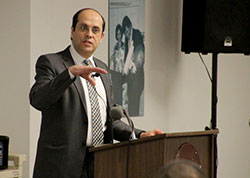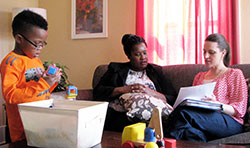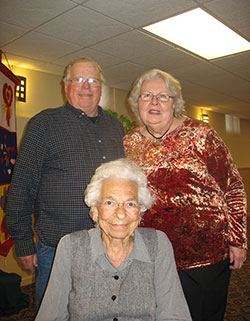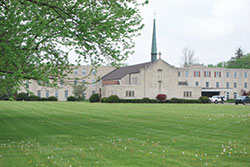Catholic News Around Indiana
Compiled by Brandon A. Evans
Diocese of Evansville
'One Size Does Not Fit All'
 By Tim Lilley
By Tim Lilley
More than 140 Catholics of diverse backgrounds heard a singular message April 29-30 in seminars covering “Best Practices for Shared Parishes.” The April 29 session was led in English, and the April 30 session in Spanish – both by Alejandro Aguilera-Titus, Assistant Director of Hispanic Affairs for the U.S. bishops’ Secretariat of Cultural Diversity in the Church.
“One size does not fit all,” Aguilera-Titus said. “The Church exists to evangelize … not to Americanize or Mexicanize … or whatever-ize.”
Throughout the seminar, Aguilera-Titus emphasized that unity in diversity makes the Church what it is – not only here in the Diocese of Evansville, but literally across the world.
“The Catholic Church is arguably the most diverse institution ever,” Aguilera-Titus said. “We are called to love one another as Christ loves us. We do that by seeking ecclesial integration, not assimilation.”
He explained that the need for integration grows more important all the time. Citing ongoing research from Georgetown University’s Center for Applied Research of the Apostolate, Aguilera-Titus reported that in 2000, 22 percent of U.S. parishes were multicultural. “By 2010, that number had grown to 33 percent,” he said. “I recently spoke to CARA about this, and the number in 2016 has grown to 38 percent.”
He added that the USCCB recognizes five Catholic “families” – African American; Asian-Pacific Islands; European-American; Hispanic-Latino; Native American; and Migrants, Refugees and People on the Move. He also noted that the Hispanic-Latino block includes 60 percent of all U.S. Catholics ages 18 and under.
In addressing the challenges facing parishes that find themselves adapting to increasingly multicultural communities, Aguilaera-Titus emphasized the need to keep God at the center of our efforts – referring to Evangelii Gaudium No. 131, in which Pope Francis says, “Diversity must always be reconciled by the help of the Holy Spirit; he alone can raise up diversity, plurality and multiplicity while at the same time bringing about unity.”
“The Holy Spirit is the only true source of unity,” he added, recalling how the Holy Spirit raised up unity on the day of Pentecost, when so many were proclaiming the Good News – and every individual heard the message in their native language.
He suggested that the keys to the kind of ecclesial integration that must take place as our parishes grow in diversity involve withholding judgment and, instead, engaging all members of parish communities in order to enable the work of the Holy Spirit to take place.
Seminar attendees received bilingual (English and Spanish) copies of the USCCB book “Best Practices for Shared Parishes: So That They May All Be One.” The book is a great resource for use in breaking open the concept of a shared parish, and for suggestions and plans to enhance ecclesial integration.
Aguilera-Titus explained that there are three levels of ecclesial integration that take place – welcoming, belonging and ownership. “They represent the roadmap for building unity in diversity,” he said.
Photo caption: Alejandro Aguilera-Titus of the USCCB leads the "Best Practices for Shared Parishes" seminar. The Message photo by Tim Lilley.
(For news from the Diocese of Evansville, log on to the website of The Message at www.themessageonline.org)
Diocese of Fort Wayne-South Bend
Institute for Church Life revives beloved Catholic tradition
NOTRE DAME — A Marian procession and May crowning will took place Sunday, May 1, at the University of Notre Dame. The procession started at the Our Lady of Lourdes Grotto behind the Sacred Heart Basilica and ended at Geddes Hall with a crowning ceremony, blessing and reception.
“Mary is the most inculturated person in the Church because she is the the mother of all people,” said John Cavadini, McGrath-Cavadini Director of the Institute for Church Life at Notre Dame. “We are so happy to restore the gift of this beautiful tradition honoring Mary, the Mother of God, for whom this university was named.”
A statute of Mary was blessed at the Grotto and processed through campus accompanied by prayer and song. The procession traveled to the Coleman-Morse Center and then passed by the Main Building on the way to the Geddes Hall Chapel where Mary was crowned and enshrined. A final blessing was offered by Holy Cross Father Terry Ehrman and a reception followed in Geddes Hall.
“Events like this nourish the Catholic imagination,” said Cavadini. “A May crowning and procession is a beautiful way to participate in a devotional practice that makes the faith more accessible, and it offers an inspiring spectacle for those who want to know more.”
The Institute for Church Life at the University of Notre Dame connects the intellectual life of the academy to the pastoral needs of the Catholic Church. Dedicated to forming faithful Catholic leaders at all levels of Church life, the institute partners with dioceses, parishes and schools to offer programming and resources in theology education, faith formation and leadership development.
Hannah’s House and Bridge of Hope offer possibilities for future
 By Michelle Donaghey
By Michelle Donaghey
MISHAWAKA — Being a mother is hard enough. But imagine being alone and pregnant or a single mom holding multiple jobs, living with friends and family and constantly moving from place to place. These situations can feel like a nightmare that will never end.
“You can’t reach your goals because life is always busy, there is always something else. It’s very, very stressful when you are in survival mode,” says Raina, 41, a single mom of a four year old son who says she sometimes held two to three jobs simultaneously when raising her older children. Raina recently was accepted into the Bridge of Hope mentoring program at Hannah’s House. She can’t say enough about this wonderful opportunity to set goals, learn more about self-sufficiency, develop a budget and return to school to make a better future for herself and her young son.
Single mom to be, Shayla, is expecting her first child any day. She is grateful for Hannah’s House which has provided her with a home that is “quiet, with meals three, sometimes four times a day,” as well as structure — a peaceful setting and wonderful moral support,” she says smiling while stirring up lunch in a crockpot.
Different, yet similar possibilities for hope — both offered through Hannah’s House.
Located in Mishawaka, Hannah’s House is a Catholic-Christian agency offering a continuum of services for pregnant and parenting single women facing homelessness. Its maternity home offers stability, including shelter and programming for up to seven pregnant women at a time. While living in this highly structured environment, women set goals related to their physical, emotional and spiritual health and pursue education/employment. With staff support, they prepare for the demands of single-parenting or make the courageous choice to place their baby for adoption. Moms-to-be have regular chores, help plan and cook meals and are required to attend church. Mornings begin with a devotional time and evening meals include grace led by the resident who prepared the meal. Women may come to Hannah’s House at any point in their pregnancy and stay for the first few months after giving birth. Those with jobs and child care in place may transition afterwards to the unstaffed Killilea Home just across the street to put into practice their new self-sufficiency skills.
Photo caption: Raina, who recently was accepted into the Bridge of Hope program, works with Family Resource Coordinator, Kristi Kubicki, MSW, for Bridge of Hope at Hannah’s House to set up a workable budget while her young son, TyeRon, plays near her. The two women will meet regularly as part of the program. This meeting was held in the living room area at Hannah’s House in Mishawaka on Fourth Street.
Harvest House movement in need of laborers
 By Vince LaBarbera
By Vince LaBarbera
This Scriptural passage from the Gospel of St. Luke certainly applies to the St. Michael/St. Anthony Harvest House movement. The two parishes — St. Michael the Archangel in Waterloo and St. Anthony of Padua in Angola, have joined together for the purpose of mutual understanding, self-help and community service in a movement called Harvest House.
Founded in 1972 by Holy Cross Father Louis J. Putz, in South Bend, Harvest House was set up in the Diocese of Fort Wayne-South Bend as a six-point program to help adults age 55 and over assert themselves as an important part of our society, said Jim Garman, co-president of the combined group. The six-part program includes social awareness, service to others, new religious experiences, continuing education, celebration and recreation, and community involvement.
Officially, Harvest House is dedicated to the purpose that older adults acknowledge their value and their dignity, and that they come together in organization to remain active and alert members of society.
Other office holders of the movement, begun in 1980, include Jeff Heil, co-president; Sharon Garman, secretary; Maggie Miller, treasurer; and Father David Carkenord, pastor of St. Michael’s Parish, spiritual director.
Other parishes with combined Harvest House movements include Immaculate Conception, Auburn and St. Joseph, Garrett; and St. Rose of Lima, Monroeville and St. Louis, Besancon.
As part of their “social awareness” program, Harvest House groups meet on the fourth Thursday of the month, usually at 11 a.m. The rosary is recited at 11:10 a.m. followed by Mass at 11:30 a.m. A carry-in pot luck follows with entrees prepared by one or two volunteer members or a luncheon is held at a local restaurant.
“After lunch we often have a speaker to fulfill the “continuing education” portion of our group, but if no one of interest is available, we play Bingo,” Jim Garman said. On the day that Today’s Catholic visited the monthly meeting in Waterloo, the speaker was Marsha Wright, Garman’s classmate, who presented a program about Margaret Ringenberg, born in Fort Wayne, who began her aviation career in 1943 during World War II when she became a ferry pilot with the Women Airforce Service Pilots (WASP). She logged more than 40,000 hours of flying time during her career.
To provide “service to others,” members volunteer at local nursing homes, call on shut-ins and on those who are ill, and transport the elderly to Mass, meetings and other functions, Garman continued.
Once a year all the groups attend Older Americans Day held at various parishes.
Photo caption: Jim and Sharon Garman (standing), co-president and secretary, respectively, of St. Michael and St. Anthony of Padua Harvest House movement, pose for a photo with past president Mary Ann Heitz. Jim was a maintenance worker at Immaculate Conception Parish, Auburn, and Sharon served as the director of religious education at St. Michael, Waterloo.
(For news from the Diocese of Fort Wayne-South Bend, log on to the website of Today’s Catholic at www.todayscatholicnews.org)
Diocese of Gary
No news briefs are available this week
(For news from the Diocese of Gary, log on to the website of the Northwest Indiana Catholic at www.nwicatholic.com)
Diocese of Lafayette
Lafayette diocese purchases former motherhouse and retreat center from Congregation of St. Joseph
 By Kevin Cullen
By Kevin Cullen
TIPTON — She’s in her 80s, but Sister Rosie Coughlin, CSJ, says she hasn’t been this excited “since I was a child. Our hopes and dreams have come true!”
At a press conference April 29, her community — the Congregation of St. Joseph — announced the sale of its Tipton motherhouse and retreat center to the Diocese of Lafayette-in-Indiana.
The 43-acre tract, at 1440 W. Division Rd., north of Tipton, includes farm acreage, plus six major buildings, including the motherhouse and chapel, a gymnasium, and four houses.
It will be used for a centrally located diocesan retreat and conference center that also will be available to community groups, Bishop Timothy L. Doherty said. He cited potential benefits for the diocese, the sisters, St. John the Baptist Parish in Tipton, and the Tipton community.
The purchase “will strengthen the mission of the diocese and reinforce our ecclesial identity within our own diocesan boundaries,” he said. The property is at the approximate population center of the 24-county diocese.
“This is sacred ground for you, and it will continue to be sacred ground for us,” he told the sisters. He added that it will be a “great honor” to continue their mission and neighborliness.
“The grace of God got us here,” he said. “... We want to be a positive presence and asset for the community.”
The motherhouse building, constructed in 1957, has 74,244 square feet of space, including 83 apartments with individual baths, a conference room, elevator, dining room, kitchen, library, laundry room, reception area and offices.
Talks are under way with St. John the Baptist Parish in Tipton, which was forced to vacate its church because of major structural problems. Part of the former motherhouse could be used by the parish on weekends until a new church is built. Masses are now being celebrated in the gym of the former parish school.
“There’s nothing definite yet,” said pastor Father Dennis Goth. “We’re still thinking and talking about it.
“I’m excited about the purchase,” he said. “It will be good for the diocese. It’s a beautiful resource.”
The Sisters of St. Joseph of Tipton — which later merged with other communities to form the Congregation of St. Joseph — occupied the property from 1888 until 2012. For many years, they operated the motherhouse there, plus a day school and boarding school for high school girls.
The “Tipton sisters” once served 15 parish schools and ran hospitals in Kokomo and Elwood. When the Tipton motherhouse closed in 2012, most of the sisters moved to other cities, but three still live in Tipton and Elwood.
Photo caption: The 43-acre tract north of Tipton includes farm acreage, plus six major buildings, including the motherhouse and chapel, a gymnasium and four houses. It will be used for a centrally located diocesan retreat and conference center that also will be available to community groups. (Photo by Kevin Cullen)
High-school teens answer the call to be ‘Battle Ready’
 By Caroline B. Mooney
By Caroline B. Mooney
KOKOMO — In every civilization in the history of mankind, the more people move away from God, the more they move toward chaos. That happens in personal lives as well, says Doug Barry.
“Our souls are on the line. The decisions we make in this world affect where you go in the next,” said the keynote speaker at The Call High School Retreat XIII.
The Call brought 58 high- school students together for a weekend of faith, spirituality and fellowship April 30-May 1 at St. Joan of Arc Church.
The theme was “Battle Ready,” and the weekend included motivational talks, breakout sessions, Mass, Eucharistic adoration, and the opportunity for reconciliation.
Ann Campbell and Brian Campbell, coordinator for youth and young adults at St. Joan of Arc, organized the retreat with the help of a 10-member youth council.
Bimonthly planning began in July 2015 for this year’s event. Approximately 60 volunteers assisted throughout the weekend.
Youth came up with the theme, planned skits, designed T-shirts and e-mailed monasteries across the country requesting prayers.
“We pray all the time and keep asking for God’s direction,” Brian Campbell said. “Satan didn’t want us to have this. We had to reschedule twice and this late in the school year, it’s harder to get people here.
“Kids need something to re-center their lives on,” he said. “We all need a retreat, but don’t always make time for them. This year’s theme — ‘Battle Ready’ — has been my mantra in life as I try to help catechize kids. The bottom line is, this is about your soul.
“I like the excitement that I see in the youth who enjoy coming and those who keep coming back,” Campbell said. “Volunteers enjoy being a part of this, because it creates a great energy when you can see the fruit of the work. That makes a difference. We may never know how it reaches teens, as far as their spirituality and their faith. But it’s like anything else we do as Christians — if we let God plant the seeds, he will also nourish it.”
Barry has been in ministry for 26 years and founded RADIX because he was once called “a Mary radical.”
“That has a fanatical connotation, but it’s a good thing,” he said. “You can be radical for anything, but we are often radical for the wrong things, like excessive sports, food, entertainment and material things. We can be radical for evil things such as pornography, domestic violence, addictions and premarital sex.”
Barry said the idea behind his RADIX ministry was to get to the root of who we are and what we are created to be radical for.
Photo caption: Doug Barry speaks to youth at The Call retreat, held April 30-May 1 at St. Joan of Arc Parish in Kokomo.
(For news from the Diocese of Lafayette, log on to the website of The Catholic Moment at www.thecatholicmoment.org)
 By Tim Lilley
By Tim Lilley By Michelle Donaghey
By Michelle Donaghey  By Vince LaBarbera
By Vince LaBarbera  By Kevin Cullen
By Kevin Cullen By Caroline B. Mooney
By Caroline B. Mooney